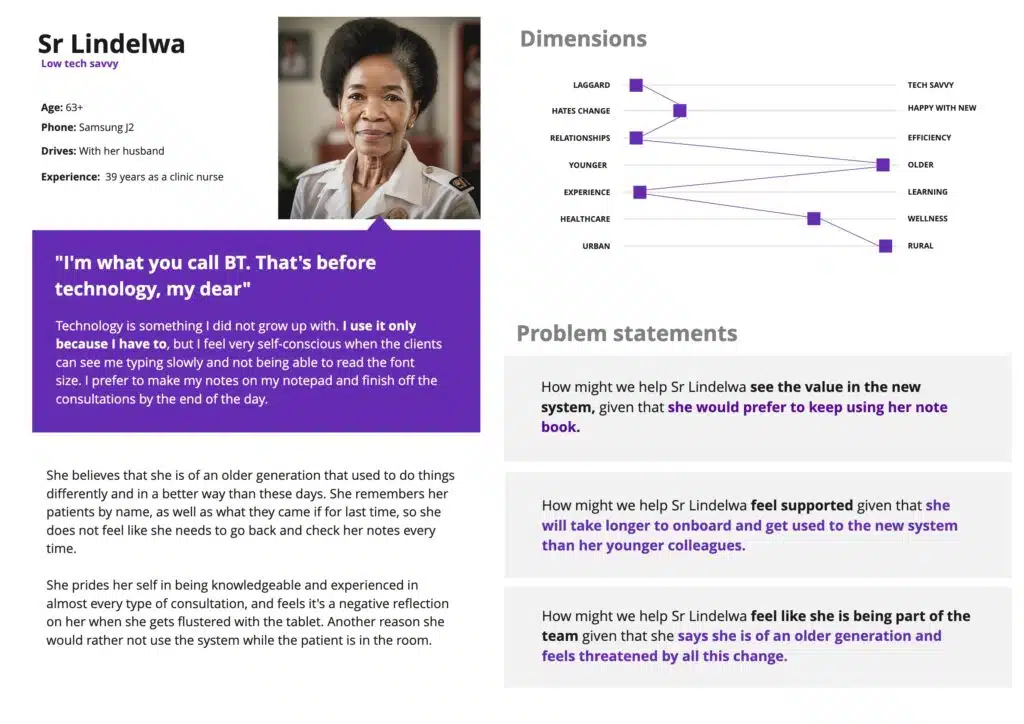Over the last decade or so we have been involved in a number of discussions about the value that personas play in the design process. When Jobs-to-be-done (JTBD) started becoming popular, we too thought it was the upgrade to personas that we have been waiting for. But years after implementing JTBD in our workshops and design process, we are still using personas and probably will for a while. We find it works really well with JTBD too.
The personas that we create are not market segmentation. They are not used to understand how large your target market is, or what demographic they are. They are also not used for large strategic business decisions. They don’t need to be printed out as massive banners hanging under the corporate office lifts. They, just like most journey maps, are tools we use to help designers create great experiences. They are an aid in the design process, not a final deliverable.
The personas we create do two things:
1) They allow the designers to have honest conversations with themselves, each other, and stakeholders about customers.
2) They help to sort and categorise customer needs.
Help with design conversations
For a designer to be able to make anything for another person, they need to imagine how the other person will interact with the things they’re designing. This happens constantly. With every stage of the journey, every new button added, every word of the copy. The designer needs to be thinking “How could our customers perceive this?” Trying to do this with an undefined group of people is hard. It’s much easier to ask yourself “How could Mary perceive this?” This is the same when having a conversation with team members. It’s much easier to use a persona name than explain the customer each time they discuss design choices.
Having this emotional connection with an individual is extremely helpful when creating something. And as we know, it does not need to be a real human, just a believable and realistic one.
A way to group needs
We really like Jobs-to-be-done as a way to capture customer needs. But, people with different motivations and behaviours, have different needs. We have found that attaching JTBD to a persona allows us to easily group the needs and adds an additional emotional aspect to each need. It makes each need easier to understand when you understand the motivations.
The hesitancy
Despite these benefits, some people feel that personas are not worth the time needed to create them. One of the main criticisms of personas is that they can be overly simplistic and not reflect the complexity of real users. Critics argue that personas often rely on stereotypes and assumptions, rather than real user data. While there is some truth to this criticism, it is important to note that personas should never be created with little to no knowledge of the customer. Instead, personas should be based on real user data, such as user interviews, surveys, and analytics. By using real data to create personas, designers can avoid relying on assumptions and stereotypes.
Another criticism of personas is that they can be too focused on the individual user, rather than the broader context in which they operate. However, this can be addressed by creating multiple personas that reflect the diversity of the user base. By creating a range of personas that represent the edges of the target market, designers can better understand the different motivations and behaviours of their users. When they design something that works for the edges of the customer base, everyone in between is looked after too.
Who are they for?
Personas are not for everyone in the business, but we feel they are essential for the product team, especially the designers. So if you are not a designer and find yourself in a persona workshop wondering why you are there, remember that this tool might not be useful to you, but it will be for your product team, and your input will help.
 An example of a persona we have created in the past
An example of a persona we have created in the past
Topics not in this article
We can discuss many aspects of using personas for days, but unfortunately, it’s impossible to cover them all in one article. For example, we did not cover the design of a good persona, how dimensions work, or the differences between an archetype and a persona. But worry not—we will do our best to cover those in future posts.